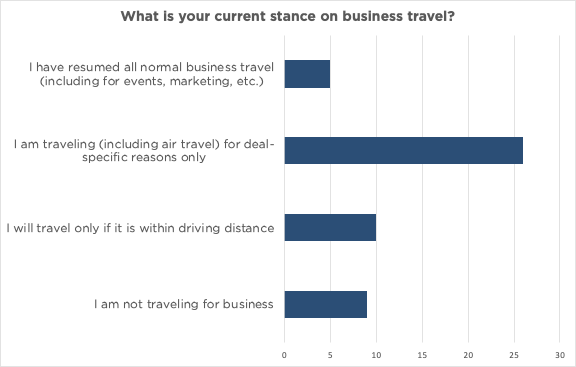
LMM Deal Digest: March 2025
2020 has been a year that many are eager to put in the past. However, as we ready ourselves to close out a very tumultuous chapter, it seems that we are being met with even more uncertainty going into the year ahead. With a vaccine on the horizon, a new administration entering office, and the continued haze of COVID clouding the world, setting expectations and making decisions for 2021 has become a near-impossible task.
Planning business travel in particular has become a bit of a chicken-and-egg scenario. Many wish they could travel, but there are no meetings to travel for. Some are open to attending events, but there are no events to attend. Furthermore, many are theoretically ready to resume a pre-COVID lifestyle, but when push comes to shove, few are actually going through with it at the moment.
In an effort to get a bit more insight into what the lower middle market truly thinks, Axial surveyed 50 deal professionals (50% buy-side firms, 50% sell-side firms) around expectations for travel and in-person meetings in 2021. Below, we’ve summarized their responses.
Current Stance on Business Travel
From what we’ve seen, today’s travel habits are fairly aligned with what one would expect. While there are a few deal professionals who have resumed normal pre-COVID business travel (and some who have not resumed any travel at all), the lion’s share of Axial survey respondents seem to be traveling for deal-related purposes only.

Max Prilutsky, Founder & Managing Partner of Roadmap Advisors is a sell-side Axial member who falls within this majority. “We are limiting travel only to critical deal-related meetings where a video call would be insufficient,” he says. “With COVID-19 cases at an all time high around the country, getting on planes to meet with clients not only puts our team at risk, it puts the clients we meet with, their businesses, and their families at risk as well.”
Martis Capital, a healthcare-focused private equity firm based in California is on a similar page. “I think high-stakes, targeted travel will return sooner than general event travel,” said Vladimir Andonov, the firm’s Director of Business Development who is used to being on the road often. Andonov went on to say that Martis employees have begun to get back on the road when they feel it is important and safe to do so. “Our senior investment professionals have traveled already during COVID – advanced diligence on an opportunity or for interviewing of C-suite executives for our portfolio companies – and I expect that to continue into 2021, for our firm and beyond.”
What Does This Mean for Events?
In addition to traveling for one-off meetings, a major part of lower middle market deal sourcing revolves around meeting higher concentrations of firms at events. Some of these events focus specifically on one-on-one meetings, while others are more broadly focused on general networking. And while there has been an effort from a multitude of organizations to recreate both of these formats virtually, not all have fared well.
Andonov has attended a variety of virtual events over the past eight months, and he has seen a clear divide around what works and what doesn’t. “Virtual events that were a substitute for one-on-one in-person events have generally worked well. It’s certainly better than no event and it also is more efficient (time and cost wise). . . The events that haven’t worked so well are the industry conferences – a lot of conversation and informal deal making usually happens in the hallways, around the main speaking events & panels.”
This is an opinion that has been echoed by Axial members many times over since the start of the pandemic, and it proves that there is a place for both virtual and in-person events in our future. It has become obvious to Axial that virtual events will remain a staple format even after travel makes a comeback, because they eliminate geographic roadblocks, reduce costs (both for the producer and the attendee), and greatly increase efficiency. And on the flip side, as Prilutsky says, “[There is] no replacement for the in-person relationship building that happens while spending time with folks in-person at live events.”
When it comes down to it, the market sees value in both formats, and I think it’s safe to say that many will ultimately choose to split their resources and budgets, attending a combination of in-person and virtual wherever it makes sense to do so.

Speaking of Budgets…
When it comes to budgeting for events in 2021, firms seem to be all over the map right now. While about half of survey respondents said that their budget for event attendance would remain the same (or similar) next year, there was a divide as to how that budget would then be split. Many firms say they plan to split in-person and virtual event spend evenly, while some plan to dedicate a higher percentage towards virtual (only one person from that cohort planned to keep 100% of their 2021 budget focused on in-person opportunities).
The remaining 50% of respondents were even more divided than the first group. Some firms plan to take savings from halted travel this year and increase their budget in 2021. Others have committed to decreasing the events budget across the board, and multiple firms are going to scrap a predetermined budget in favor of assessing ROI on a case-by-case basis.
Our takeaway? COVID/post-COVID budget is one area where there’s not a lot of consensus.
So… When Might We See One Another Again?
With such a focus on the in-person events that aren’t happening, it is important to note that there are organizations who have actually begun dipping a toe back in the water. Lower middle market investment bank Lawrence Evans & Co. recently hosted an in-person gathering for about 25 attendees, many of them business owners. Following a successful event, the firm plans to host 1-2 similar gatherings in the coming months (pending no dramatic increase in COVID-19 outbreaks).
“Generally, we had a good response to our invitations,” Neil Johnson, Managing Partner at the firm told us. “Some companies did restrict participation — there were instances where business owners wanted to attend but after telling employees they shouldn’t go anywhere, they ultimately had to lead by example. But overall, everyone seemed happy to get out, put on a sport coat (hoping it would fit) and have a drink.”
So, the wheels are turning, albeit slowly. The transition back to in-person events will rely heavily on creativity and flexibility, but where there’s a will, there’s a way. Until then (and even after) we’ll continue to supplement our client’s business development with high-quality, virtual opportunities. And as soon as it is safe and plausible to do so, we’ll be among the first inviting you out for a drink.
As Prilutsky puts it: “Hopefully people will still remember how to shake hands at the end of all this.”
